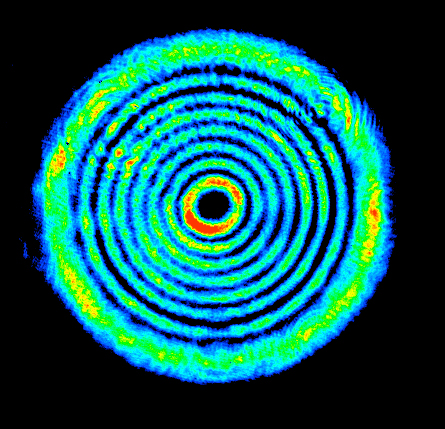A record quantum entanglement: 103 dimensions
March 31, 2014

An example of intensity distributions belonging to different modes of photons. Each of these modes corresponds to one of the distinguishable states that were entangled in the experiment. (Credit: Krenna et al.)
An international team of researchers has created an entanglement of 103 dimensions with only two photons, beating the previous record of 11 dimensions.
The discovery could represent an advance toward toward better encryption of information and quantum computers with much higher processing speeds, according to a statement by the researchers.
Until now, to increase the “computing” capacity of these particle systems, scientists have mainly turned to increasing the number of qubits (entangled particles), up to 14 particles.
The research team was directed by Anton Zeilinger and Mario Krenn from the Institute for Quantum Optics and Quantum Information of the Austrian Academy of Sciences.
In an article published this week in the journal Proceedings of the National Academy of Sciences (PNAS), scientists described how they managed to achieve a quantum entanglement with a minimum of 103 dimensions with only two particles.
Instead of entangling many particles with a qubit of information each, scientists generated one single pair of entangled photons in which each could be in more than one hundred states, or in any of the superpositions of theses states; something much easier than entangling many particles. These highly complex states correspond to different modes in which photons may find themselves in, with a distribution of their characteristic phase, angular momentum, and intensity for each mode.
“This high dimension quantum entanglement offers great potential for quantum information applications. In cryptography, for example, our method would allow us to maintain the security of the information in realistic situations, with noise and interference. In addition, the discovery could facilitate the experimental development of quantum computers, since this would be an easier way of obtaining high dimensions of entanglement with few particles”, explains Universitat Autonoma de Barcelona (UAB) researcher Marcus Huber.
“The most immediate practical use is expected to be in secure communication,” Huber explained to KurzweilAI in an email interview. “Harnessing the full potential of the information carrying capacity of photons does not only hold the potential to greatly improve key rates in quantum key distribution scenarios, but might actually enable secure quantum communication with a much higher level of noise (which is one of the main obstacles in commercial implementation).
“There are many research groups worldwide that focus on different aspects of this orbital angular momentum. We have performed the first experiment exploring the full potential of entanglement in these degrees of freedom that is available with current technology and have shown that this potential exceeds current experiments almost by an order of magnitude in dimension. Commercially available quantum key distribution systems based on two-dimensional entanglement already exist. In principle, the technology we use can directly be employed and systems upgraded. There are however some fundamental technical challenges that need to be overcome before such a technology kicks off.
“The main problem is the inevitable noise that will destroy any entanglement if distributed over a long range. To that end, concepts like teleportation can be used to build quantum repeaters that extend the range of distributing two-dimensional entanglement in larger networks. Devising setups capable of teleporting and repeating high dimensional entanglement is one of the key challenges that thus need to be addressed prior to a large scale commercial availability.”
Abstract of arXiv paper
Entangled quantum systems have properties that have fundamentally overthrown the classical worldview. Increasing the complexity of entangled states by expanding their dimensionality allows the implementation of novel fundamental tests of nature, and moreover also enables genuinely new protocols for quantum information processing. Here we present the creation of a (100×100)-dimensional entangled quantum system, using spatial modes of photons. For its verification we develop a novel nonlinear criterion which infers entanglement dimensionality of a global state by using only information about its subspace correlations. This allows very practical experimental implementation as well as highly efficient extraction of entanglement dimensionality information. Applications in quantum cryptography and other protocols are very promising.